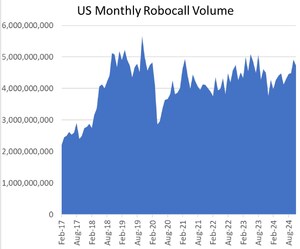Robocalls Top 50.3 Billion in 2022, Matching 2021 Call Volumes Despite Enforcement Efforts
U.S. Phones Received 4.3 Billion Robocalls in Month of December, Says YouMail Robocall Index
IRVINE, Calif., Jan. 5, 2023 /PRNewswire/ -- US consumers received over 50.3 billion robocalls in 2022, only slightly less than the 50.5 billion total robocalls received in 2021 despite widespread enforcement efforts by government regulators and state officials.
Americans received just under 4.3 billion robocalls in December, marking a 10.1% decrease from November's monthly volume, and a 13.0% decrease on a daily basis. Specifically, December averaged 137.6 million calls/day and 1,831 calls/second, compared to November which averaged 158.2 million calls/day and 1,593 calls/second.
December's decline was a welcome respite after the growing call volume over the past few months. The decline is likely driven by robocallers taking time off for the holiday season and the disappearance of election-oriented robocalls.
"The big picture is that robocall volume in the US isn't really changing, despite month to month variations, and despite stepped up enforcement and the roll out of Stir/Shaken," said YouMail CEO Alex Quilici. "It feels like mitigation efforts are keeping things from getting worse, but aren't making them materially better. It's clear that consumers continue to need to protect themselves with robocall blocking apps like YouMail, since the problem is just not going to magically go away."
These latest figures are provided by YouMail, a totally free robocall blocking app and call protection service for mobile phones. These figures are determined by extrapolating from the robocall traffic attempting to get through to YouMail's millions of active users.
For the third month in a row, the most unwanted robocall campaign involved a solicitation for potential medical compensation related to Camp Lejeune, as in this example. This campaign continued in December to make tens of millions of robocalls from thousands of different numbers. Like many other illegal telemarketing or scam calls, they appear to be violating a variety of telemarketing regulations, as they do not immediately identify the entity making the call, do not provide a call back number, and appear to be calling people who did not give prior consent. Here is the call transcript:
"Please listen carefully. You may have potential compensation due to you if you would like to opt out, please press one immediately. Once again, if you would like to opt out, please press one immediately. This message is in regards to Camp Lejeune. If you or anyone you know visited Camp Lejeune from August 1st, 1953 through December 31st, 1987 and developed medical complications, diseases and medical issues, you were likely due compensation due to being exposed to toxic water and contamination. To join to get compensation simply press two to speak to a case specialist. Once again this is for anyone you know that attended Camp LeJeune between from August 1st, 1953, through December 31st, 1987 and developed medical complications, diseases and other medical issues, you were likely due compensation. Press two to speak to a case specialist."
Americans received roughly 1.7 billion unwanted scam and telemarketing calls in December, a decrease of nearly 700 million calls from November. Scam and spam robocalls together now make up roughly 41% of all robocall volume, accelerating the recent downward trend from the highs when they made up 60-70% of all robocalls. Another positive trend is that the volume of obvious scam calls appeared to go down 30%, although telemarketing calls were down about 13%.
Type of |
Estimated December |
Percentage December |
Notifications |
1.45 billion (-5%) |
34% (+2%) |
Payment Reminders |
1.05 billion (+3%) |
25% (+4%) |
Telemarketing |
1.14 billion (-13%) |
26% (-1%) |
Scams |
.63 billion (-30%) |
15% (-5%) |
Some calls initially viewed as telemarketing are eventually recognized as illegal telemarketing or scam calls, so it's important to measure the overall quantity of scam and spam calls combined. A scam call is one that has clearly illegal or fraudulent behavior, such as a call from an enterprise imposter, or one that has a spoofed caller ID. Stir/Shaken continues to reduce the number of robocall campaigns based on spoofed IDs, which drives down the number of obvious scam calls by making them harder to detect, since they appear to be telemarketing campaigns unless there is other evidence of fraud.
The cities, area codes, and states getting the most robocalls in December were identical to November, despite a significant decline in volume for many of them.
Cities with the Most Robocalls:
|
Atlanta, GA (174.2 million, -11%) Dallas, TX (157.5 million, -8%) Chicago, IL (145.0 million, -7%) |
Cities with the Most Robocalls/Person:
|
Baton Rouge, LA (42.7/person, -4%) Memphis, TN (36.1/person, -10%) Macon, GA (32.5/person, -10%) |
Area Codes with the Most Robocalls:
|
404 in Atlanta, GA (72.2 million, -12%) 832 in Houston, TX (59.9 million, -11%) 678 in Atlanta, GA (57.5 million, -9%) |
Area Codes with the Most Robocalls/Person:
|
404 in Atlanta, GA (59.1/person, -12%) 225 in Baton Rouge, LA (42.7/person, -4%) 901 in Memphis, TN (36.1/person, -10%) |
State with the Most Robocalls:
|
Texas (501.8 million, -11%) California (308.1 million, -9%) Florida (342.1 million, -9%) |
State with the Most Robocalls/Person:
|
Louisiana (26.9/person, -7%) South Carolina (25.2/person, -10%) Alabama (23.0/person, -13%) |
These data points are provided by YouMail, a free call protection app for mobile phones. YouMail recently won the American Business Awards' Gold Stevie Award for Technical Innovation of the Year, and the YouMail app was named the nation's best robocall-blocking solution in a competition organized by Geoffrey Fowler of the Washington Post.
YouMail blocks unwanted robocallers by making sure the user's phone doesn't ring, and then plays an out-of-service message that leads them to think they dialed an invalid number. YouMail identifies problematic numbers and robocalls using a combination of its recently patented audio fingerprinting technology, call patterns, and consumer feedback.
YouMail provides the YouMail Robocall Index to estimate robocall volume across the country and for specific area codes every month. This estimate is formed by extrapolating from the behavior of the billions of calls YouMail has handled for its users, and these statistics are regularly cited by the FCC as a definitive source for national data trends.
For a full ranking of cities, states and area codes, as well as details on the behavior of robocallers in each area code, please see http://robocallindex.com. To listen to actual voice messages left by robocallers, please visit the YouMail Directory. To join the YouMail Robocall Index mailing list, please write to [email protected].
YouMail protects consumers, enterprises, and carriers from harmful phone calls. YouMail provides US and UK consumers app-based call protection services through the YouMail, Another Number, and HulloMail apps. These solutions answer over a billion live calls per year across well over 10 million registered users, powering America's most robust telephone sensor network in identifying and providing zero-hour protection against illegal calling campaigns and cyberattacks. YouMail Protective Services leverages this sensor network to protect consumer-facing enterprises by detecting and helping shut down imposter traffic that can lead to financial or brand damage, as well as to protect carriers with robocall mitigation services that detect and help stop bad traffic originating, traversing, or terminating on their networks. This sensor network is also used to provide the YouMail Robocall Index™ is the nation's definitive source on telephone network activity and attacks. YouMail, Inc. is privately funded and based in Irvine, California.
Contact:
Rohan Notaney for YouMail
Lumina Communications
[email protected]
SOURCE YouMail Inc.

WANT YOUR COMPANY'S NEWS FEATURED ON PRNEWSWIRE.COM?
Newsrooms &
Influencers
Digital Media
Outlets
Journalists
Opted In





Share this article